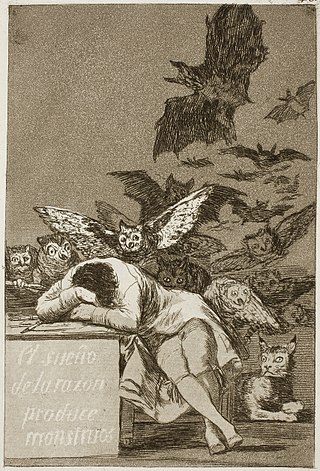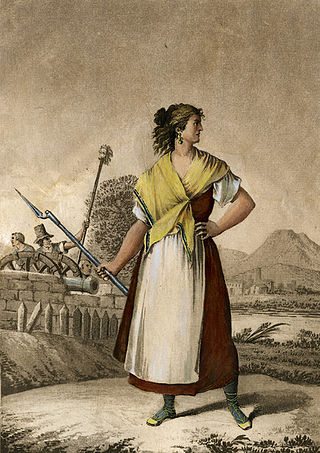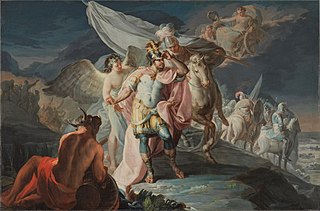
Francisco José de Goya y Lucientes was a Spanish romantic painter and printmaker. He is considered the most important Spanish artist of the late 18th and early 19th centuries. His paintings, drawings, and engravings reflected contemporary historical upheavals and influenced important 19th- and 20th-century painters. Goya is often referred to as the last of the Old Masters and the first of the moderns.

Zaragoza also known in English as Saragossa, is the capital city of the province of Zaragoza and of the autonomous community of Aragon, Spain. It lies by the Ebro river and its tributaries, the Huerva and the Gállego, roughly in the centre of both Aragon and the Ebro basin.

Aquatint is an intaglio printmaking technique, a variant of etching that produces areas of tone rather than lines. For this reason it has mostly been used in conjunction with etching, to give both lines and shaded tone. It has also been used historically to print in colour, both by printing with multiple plates in different colours, and by making monochrome prints that were then hand-coloured with watercolour.

Fuendetodos is a town in the Campo de Belchite comarca (county), in Aragon, Spain, located about 44 kilometers south-east of Zaragoza. As of 2011, it had a population of approximately 178.

Los caprichos is a set of 80 prints in aquatint and etching created by the Spanish artist Francisco Goya in 1797–1798, and published as an album in 1799. The prints were an artistic experiment: a medium for Goya's condemnation of the universal follies and foolishness in the Spanish society in which he lived. The criticisms are far-ranging and acidic; the images expose the predominance of superstition, the ignorance and inabilities of the various members of the ruling class, pedagogical short-comings, marital mistakes and the decline of rationality. Some of the prints have anticlerical themes. Goya described the series as depicting "the innumerable foibles and follies to be found in any civilized society, and from the common prejudices and deceitful practices which custom, ignorance or self-interest have made usual".
Pablo Amancio Borges Delgado is a Cuban artist.

The Sleep of Reason Produces Monsters or The Dream of Reason Produces Monsters is an aquatint by the Spanish painter and printmaker Francisco Goya. Created between 1797 and 1799 for the Diario de Madrid, it is the 43rd of the 80 aquatints making up the satirical Los caprichos.

The Colossus, is known in Spanish as El Coloso and also El Gigante, El Pánico and La Tormenta. It is a painting traditionally attributed to Francisco de Goya that shows a giant in the centre of the canvas walking towards the left hand side of the picture. Mountains obscure his legs up to his thighs and clouds surround his body; the giant appears to be adopting an aggressive posture as he is holding one of his fists up at shoulder height. A dark valley containing a crowd of people and herds of cattle fleeing in all directions occupies the lower third of the painting.

The Goya Museum is an art museum located in Castres, France. The museum was originally established in 1840 and was named after the Spanish painter Francisco Goya since it specialised in hispanic art from 1947.

Los disparates, also known as Proverbios (Proverbs) or Sueños (Dreams), is a series of prints in etching and aquatint, with retouching in drypoint and engraving, created by Spanish painter and printmaker Francisco Goya between 1815 and 1823. Goya created the series while he lived in his house near Manzanares on the walls of which he painted the famous Black Paintings. When he left to France and moved in Bordeaux in 1824, he left these works in Madrid apparently incomplete. During Goya's lifetime, the series was not published because of the oppressive political climate and of the Inquisition.

Mauricio García Vega is a Mexican painter whose work has been recognized by various awards and membership in the Salón de la Plástica Mexicana. His work is mostly focused on urban landscapes, often with dark themes and a chaotic feel. He works both alone and with his brother Antonio García Vega. He lives and works in the Mexico City suburb of Ciudad Nezahualcóyotl.

La Tauromaquia (Bullfighting) is a series of 33 prints created by the Spanish painter and printmaker Francisco Goya, which was published in 1816. The works of the series depict bullfighting scenes. There are also seven extra prints that were not published in the original edition.

The Museo Goya - Colección Ibercaja - Museo Camón Aznar is a fine arts museum in Zaragoza, Spain. It opened in 1979 under the name Museo Camón Aznar, after the art collector from the city who had contributed the nucleus of its collection. It houses also a collection of paintings and engravings by Francisco Goya.
Francisco Javier Sánchez Cantón (1891–1971) was a Spanish art historian, who from 1960 to 1968 was Director of the Museo del Prado.

Casta Álvarez Barceló was an Aragonese insurgent, who fought in the First siege of Zaragoza. This took place during the 1808 to 1814 Spanish War of Independence, or Guerra de la Independencia Española, part of the Peninsular War. She is known for inspiring the defenders of the city by single-handedly defeating an advancing French cavalry troop. Her story was popularised in a series of engravings entitled Ruinas de Zaragoza published in 1812 and 1813. For her actions, she received a pension from Ferdinand VII of Spain and, at the centenary of the siege, her body was reinterred with honour.

The Castelao building is a modern architectural building from the beginning of the 21st century located on the corner of Padre Amoedo Carballo and Sierra Street in Pontevedra, Spain, on the edge of the historic centre. It belongs to the Pontevedra Museum.

The Victorious Hannibal Seeing Italy from the Alps for the First Time, or Hannibal the victor crossing the Alps, or Hannibal the victorious from the heights of the Alps looks out over the plains of Italy is an oil painting by Spanish painter Francisco Goya, dating from his early years. It is the oldest documented work by the painter.

A Village Bullfight or A Village Corrida is an oil painting by the Spanish painter Francisco Goya.

The Casa natal de Goya is an historical house museum in Fuendetodos, Aragon, where renowned artist Francisco Goya was born in 1746. It is, since 1989, an house museum, that preserves reproductions of artworks and documents from Goya, and also objects and furniture of Aragonese style. An inscription in the façade of the house identifies it as the birthplace of Goya. Both the house museum and the contiguous Sala Zuloaga are open to the public.

















